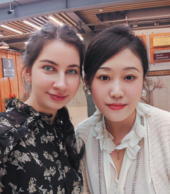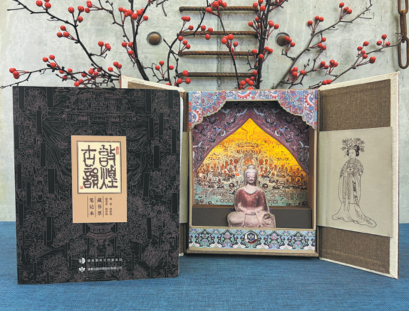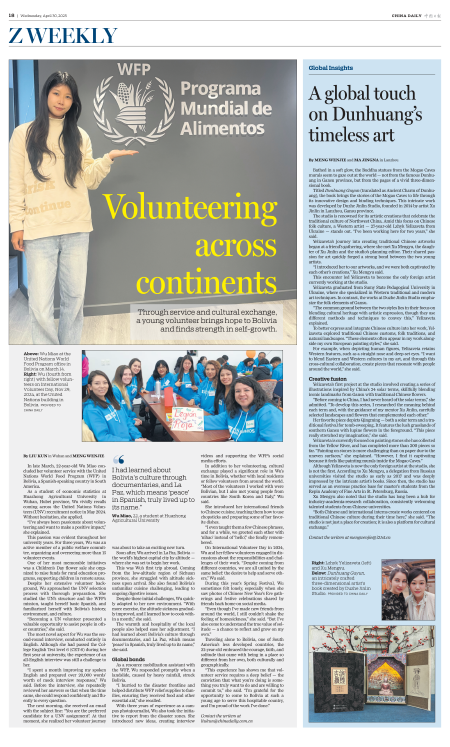
Lzhyk Yelizaveta (left) and Xu Mengyu.

Dunhuang Guyun, an intricately crafted three-dimensional artist's book created by Duzhe Jinlin Studio.
Bathed in a soft glow, the Buddha statues from the Mogao Caves murals seem to gaze out at the world — not from the famous Dunhuang in Gansu province, but from the pages of a vivid three-dimensional book.
Titled Dunhuang Guyun (translated as Ancient Charm of Dunhuang), the book brings the stories of the Mogao Caves to life through its innovative design and binding techniques. This intricate work was developed by Duzhe Jinlin Studio, founded in 2014 by artist Xu Jinlin in Lanzhou, Gansu province.
The studio is renowned for its artistic creations that celebrate the traditional culture of Northwest China. Amid this focus on Chinese folk culture, a Western artist — 27-year-old Lzhyk Yelizaveta from Ukraine — stands out. "I've been working here for two years," she said.
Yelizaveta's journey into creating traditional Chinese artworks began at a friend's gathering, where she met Xu Mengyu, the daughter of Xu Jinlin and the studio's planning editor. Their shared passion for art quickly forged a strong bond between the two young artists.
"I introduced her to our artworks, and we were both captivated by each other's creations," Xu Mengyu said.
This encounter led Yelizaveta to become the only foreign artist currently working at the studio.
Yelizaveta graduated from Sumy State Pedagogical University in Ukraine, where she specialized in Western traditional and modern art techniques. In contrast, the works at Duzhe Jinlin Studio emphasize the folk elements of Gansu.
"The common ground between the two styles lies in their focus on blending cultural heritage with artistic expression, though they use different methods and techniques to convey this," Yelizaveta explained.
To better express and integrate Chinese culture into her work, Yelizaveta explored traditional Chinese customs, folk traditions, and natural landscapes. "These elements often appear in my work alongside my own European painting styles," she said.
For example, when depicting human figures, Yelizaveta retains Western features, such as a straight nose and deep-set eyes. "I want to blend Eastern and Western cultures in my art, and through this cross-cultural collaboration, create pieces that resonate with people around the world," she said.
Creative fusion
Yelizaveta's first project at the studio involved creating a series of illustrations inspired by China's 24 solar terms, skillfully blending iconic landmarks from Gansu with traditional Chinese flowers.
"Before coming to China, I had never heard of the solar terms," she admitted. "To develop this series, I researched the meaning behind each term and, with the guidance of my mentor Xu Jinlin, carefully selected landscapes and flowers that complemented each other."
Her favorite piece depicts Qingming — both a solar term and a traditional festival for tomb-sweeping. It features the lush grasslands of southern Gansu with lupine flowers in the foreground. "This piece really stretched my imagination," she said.
Yelizaveta is currently focused on painting stones she has collected from the Yellow River, and has completed more than 200 pieces so far. "Painting on stones is more challenging than on paper due to the uneven surfaces," she explained. "However, I find it captivating because it feels like painting murals inside the Mogao Caves."
Although Yelizaveta is now the only foreign artist at the studio, she is not the first. According to Xu Mengyu, a delegation from Russian universities visited the studio as early as 2017 and was deeply impressed by the intricate artist's books. Since then, the studio has served as an overseas practice base for master's students from the Repin Academy of Fine Arts in St. Petersburg, Russia.
Xu Mengyu also noted that the studio has long been a hub for industry-academia-research collaboration, consistently welcoming talented students from Chinese universities.
"Both Chinese and international interns create works centered on traditional Chinese culture during their time here," she said. "The studio is not just a place for creation; it is also a platform for cultural exchange."
Contact the writers at mengwenjie@i21st.cn

